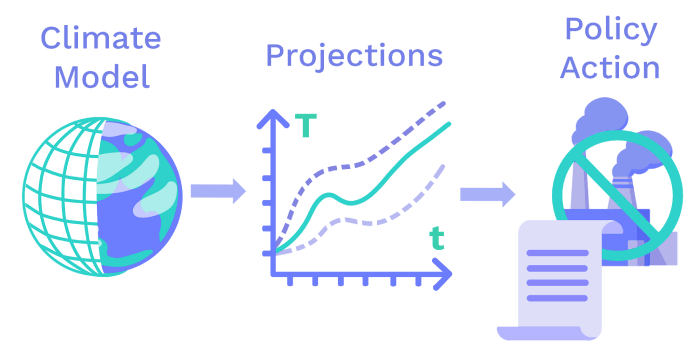Climate Models: How can we predict climate change?
5 minute read
Updated on: 03 Mar 2021
You may have heard a lot about how global temperatures are going to increase dramatically in the near future due to climate change. But how do we know this?
Sorry to all of you car-loving readers, but in this chapter we’ll actually be talking about simulations of the Earth’s climate. Still, it’s pretty cool to be able to make predictions of the future right?

Predictions to Policy Action
Review: What is the climate?
The climate system involves the atmosphere, oceans, ice, land, and all living things on Earth. Interactions between these different elements mean that the climate system changes all the time
. For example, water that forms rain on land can have evaporated from the ocean
. The climate can also be forced to change by events that are not part of the natural climate system, like volcanic eruptions
or increased CO₂ emissions
. These are called forcings
.
How do climate models allow us to do this?
Climate models make predictions by simulating the interactions between parts of the climate system and external forcings. To do this, scientists must represent these interactions using complex scientific equations
. For example, some equations will be based on making sure the energy
from the Sun is equal to all the energy absorbed or reflected by the Earth and the clouds in the atmosphere
.
Climate scientists make predictions for future climates using climate models, by putting possible scenarios for amounts of CO₂ emissions and other variables into equations.
Are climate models accurate?
Climate models have been used to make accurate predictions for the past 50 years and have got a lot better during this time
.
Scientists know this because they test their models using data from past climates. If a climate model can simulate past climates, then it is more likely to correctly simulate future climates
.
For example, the models used in a scientific report written by thousands of scientists in 2013 correctly replicated past global surface temperatures with a 99% success rate!
Scientists are constantly working to check and improve
how accurately their models make predictions, but even so, models can never be 100% accurate
.
For this to happen, scientists would need to understand and simulate every aspect of the climate system and know exactly how each and every one of us would act in the future. Without a crystal ball, this is quite difficult
!
If climate models aren’t 100% accurate, why use them?
Despite some uncertainty in climate model predictions, they are extremely useful.
A key point to realise is that climate scientists don’t need to predict the exact future to help policymakers; by using several different, well thought out scenarios of human responses to climate change (from doing nothing to doing a huge amount), climate modellers can give policymakers an idea of the range of possible changes in climate resulting from different policy actions
.
Can you see in the graph that if we don’t take any climate action, temperatures could rise by anywhere between 3°C to 10°C by 2200? We don’t know, but either way that is certainly going to be bad for us!
Climate models can inform policymakers with information and evidence to start making well-informed decisions about future environmental actions.
For example, greenhouse gas emissions will increase future temperatures and affect future weather patterns. Models can be used to predict how human activities, such as increased emissions, will affect the climate
.
Conclusion
All climate models have limitations but, properly used, they can make important contributions to tackling climate change.
Next Chapter



